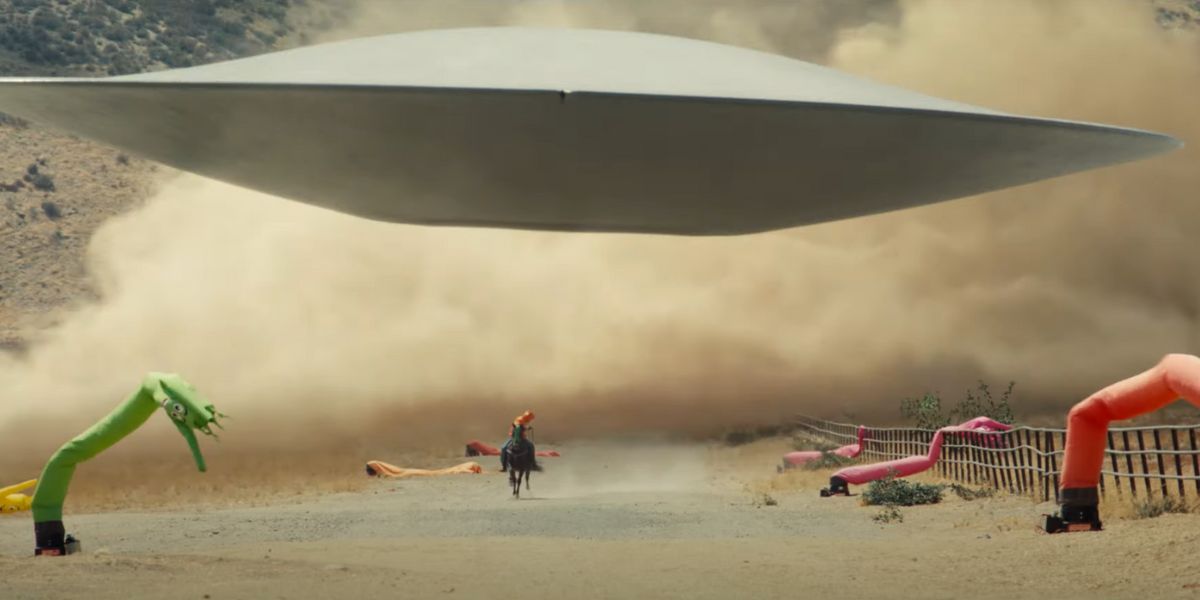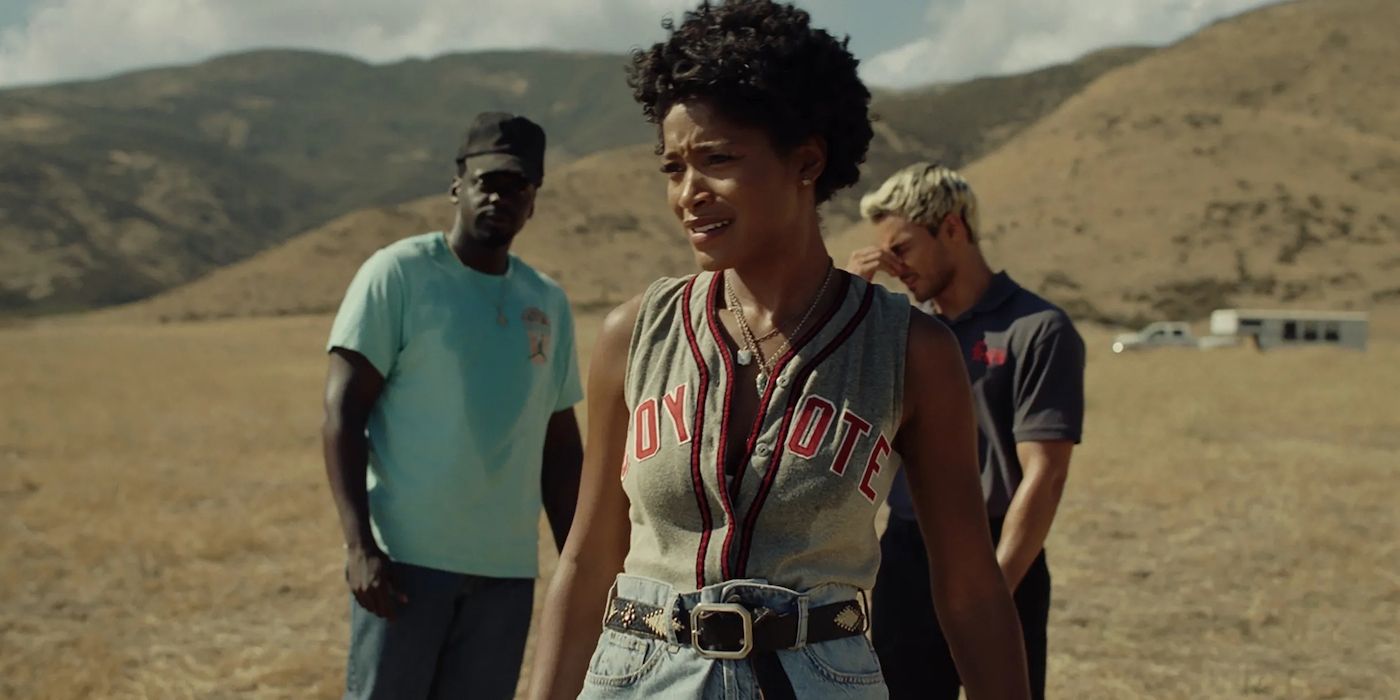Editor's note: The following includes spoilers for the film Nope
A new film by Jordan Peele has been released, and with it comes the inevitable flood of thinkpieces. As with Get Out and Us before it, Nope has been greeted with critical acclaim, box office success, and feverish social media analysis; it’s a great big cannonball right into the pool of The Discourse. People prepared their weighty interpretations of the film’s themes - spectacle, Hollywood, wild animals, trauma, capitalism, etc. - and presented them as though they were professors at a symposium. They compared and contrasted it with the franchise films that dominate the modern big-budget landscape. They argued over the purpose of the killer chimpanzee flashbacks. They roasted Logan Paul for not liking it, and roasted the guy who did that “let people enjoy things” comic for liking it too much. Even the first weekend’s box office numbers - a solid but not earth-shattering $44 million - became the subject of debate whether it could be considered an underperformance. In a way, it reinforced Nope’s theme of the spectacle: it was seen, but more importantly, it was talked about.
However, there’s a real danger of missing the forest for the trees - or the desert for the wacky waving inflatable arm-flailing tube men, as it were. Cultural analysis is nothing new, but the internet has democratized it (and incentivized it in the form of clicks and social media engagement) more than ever: not only can everyone do it, everyone feels the need to do it. Even the most straightforward movies will have their messages analyzed, their themes scrutinized, and their endings explained, all while being placed in a larger cultural context. And when it comes to movies like the ones Jordan Peele makes, which combine popularity with genuine depth, it’s time to really dig deep: hour-long video essays, college courses, and intense speculation on the significance of an orange Scorpion King hoodie.
This is not to say that media analysis is bad or unnecessary. For one thing, that would be rich coming from someone trying to make a career out of media analysis. For another thing, completely rejecting analysis - taking everything at face value, sneering at subtext and symbolism, refusing to believe that there could be even a subconscious reason why the curtains in a short story are blue - leads to incurious, unimaginative audiences who demand spoon-feeding. The problem comes when people laser-focus on themes and subtext to the exclusion of everything else, treating a work of art like a puzzle box to be solved rather than enjoyed - or worse, treating it like a carrying case for its message, as though a movie is nothing more than an overly complicated telegram.
All of this is to say that obsessing over the meaning of a film like Nope is to do it, and Peele, a disservice. It’s true that his films function as social commentary and are often quite symbolic - in Get Out, for instance, meaning can be read into everything from deer horns to the color of a drinking straw. But there are two things that Peele has that legions of post-Get Out imitators lack. He has complete command of his craft, with an eye for striking imagery and an intuitive sense for how to pace scenes for maximum suspense. And, just as importantly, he has a level of geeky, enthusiastic cinephilia to rival Quentin Tarantino. The genre elements of his films aren’t just an obligatory spoonful of sugar to help the medicine go down: Jordan Peele makes movies because he loves movies, not because a movie would get more attention than a doctoral thesis. Nope is thematically rich, as all his movies are, but first and foremost it’s a celebration of classic blockbuster filmmaking.
The central characters of Nope all exist on the fringes of Hollywood in some way. The Haywood siblings, OJ (Daniel Kaluuya) and Emerald (Keke Palmer), are animal handlers, specifically horse trainers. With the decline of the Western and the advent of CGI, their way of life is threatened even before the mysterious death of their father (Keith David), and their impending financial hardship is what motivates them to get “the Oprah shot” of the UFO (or so it seems) they discover stalking the skies above their ranch. Angel (Brandon Perea) supplies the cameras as an employee for Fry’s Electronics, a chain of stores common in Southern California before shutting down in 2021. Antlers Holst (Michael Wincott), a cinematographer with a gravelly voice and an astonishingly rad name, risks his own obsolescence due to his perfectionism and his taste for analog equipment. Even the biggest name, former child star and current traumatized theme park entrepreneur Ricky “Jupe” Park (Steven Yeun), is shown to be a desperate huckster clinging to relevance, which ends up making things worse for everyone.
That these characters function as commentary on Hollywood ruthlessness is well-documented, but less attention has been paid to the clear affection Peele has for them. In his hands, and in the hands of the actors he cast, these people are characters, not just symbols. OJ’s interactions with horses feel natural and lived-in, thanks to Kaluuya’s skilled, understated performance; through OJ’s careful demeanor and innate understanding of animal psychology, what appears to be mere competence is actually quiet, unshowy mastery. Antlers Holst, with his jarring intensity and fixation on violent wildlife footage, is undoubtedly eccentric, but there’s a tacit acknowledgment that plenty of cinematographers are just like that. (Even the colorful name feels real, considering the fact that Nope’s cinematographer is named Hoyte van Hoytema.) And there’s even the sense that Peele admires Jupe’s attempts to make lemonade from lemons; after all, most former child stars would have opened a Cameo account and called it a day.
There’s a strain of nostalgia that runs through Nope, rarely commented upon but always present: nostalgia for a weirder, riskier, more ambitious Hollywood, one that was never the utopia some claimed it to be but nonetheless crackled with vitality and creativity. It wasn’t perfect, but wonderful things could happen: a ramshackle space opera called Star Wars could become a cultural institution, or a janky robot shark could be milked for paralyzing suspense. If this were 2022 rather than the 70s, George Lucas would’ve been poached by Marvel fresh off of American Graffiti, and the shark in Jaws would be a computer-generated creation by overworked, underpaid VFX teams. There are as many brilliant craftspeople in Hollywood today as there were back then, but back then the executives hadn’t yet figured out how to replace them: the Haywoods would have thrived then. Peele honors these people by making the underappreciated “craft” elements of Nope some of the best parts. There’s van Hoytema’s spacious cinematography, vivid with desert color and capturing the quiet threat of the open sky; there’s the design of the UFO creature, which looks precisely how one expects from the outside yet is terrifying on the inside; and there’s the superlative sound design, uncanny yet possessing a visceral impact. At no point does anyone settle for “good enough.”
What’s most satisfying is that all of this is beneath the surface, enhancing the experience but not defining it. The most common comparison for Nope is Jaws, the film that more or less defined the summer blockbuster as we know it. There are plenty of obvious things they have in common. Both the shark and the UFO (that’s actually an alien itself) are predators, often seen only in glimpses, whose absence is as frightening as their presence. Both films focus on a motley crew trying to reckon with the monster in some way, whether that’s to kill it, get it on film, or both. Both films feature a crowd of people in a state of abject terror. And both have a nasty streak, unafraid of playing tricks on the audience or letting horrible things happen to children.
There’s plenty to read into Jaws, as well: it can be seen as a conflict with nature, an exploration of masculinity, a post-Watergate story of political mistrust, or even a look at science vs. spiritualism. But at its core, it’s a pulse-pounding suspense thriller about a great big nasty shark, and that’s all it needs to be. In Nope, as well as the rest of his filmography, Jordan Peele shows that he belongs in that lineage of ambitious blockbuster visionaries.


-2.jpeg)
